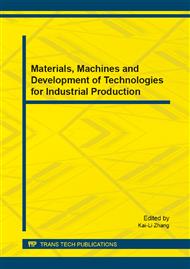[1]
Linnaeus C V, 1753. Species Plantarum. Volume 2. Stockholm; (2): Pp. 986.
Google Scholar
[2]
Koidzumi, G. Taxonomy and phytogeography of Morus. Bulletin of Sericultural Experimental Station (Tokyo). 1917, 3: 1-62.
Google Scholar
[3]
Abu-Asab M.S. &Cantino,P. D, 1992. Pollen morphology in subfamily Lamioideae(Labiatae)and its phylogenetic implications. -In: Harley R.M. &Reynolds,T. (eds. ), Advances in Labiatae sciences. Pp. 97-122. Royal Bot. Gardens. Kew.
DOI: 10.2307/2419791
Google Scholar
[4]
Abu-Asab M.S. &Cantino,P. D, 1994, Systematic implications of pollen morphology in subfamilies Lamioideae and Pogostemonoideae(Labiatae). -Ann. Missouri Bot. Garden . Pp. 81: 653-686.
DOI: 10.2307/2399915
Google Scholar
[5]
Qin, R.C., 1959. Palynology and classification. Journal of Plant Taxonomy. 17, pp.1-5.
Google Scholar
[6]
Kuprianova. L.A., 1974. The evolution stage discussion of pollen and spores form. The Chinese academy of sciences institute of botany, ancient plant laboratory (translation), Palynology translations. Beijing, science press. 1980, pp.1-10.
Google Scholar
[7]
Scgols, P., Furness, C.A., Wlkn, P., Huysman, S.S., Smets, E., 2001. Morphology of pollen and orbidules in some Dioscorea species and its system atic inp locations. Bot J linn Soc. 136, 295-311.
DOI: 10.1111/j.1095-8339.2001.tb00574.x
Google Scholar
[8]
TANAWAT CHAOWASKU, PAUL J. A. KEßLER and RAYMOND W. J. M. VAN DER HAM1, 2012, A taxonomic revision and pollen morphology of the genus Dendrokingstonia (Annonaceae) Botanical Journal of the Linnean Society, Pp. 168: 76–90.
DOI: 10.1111/j.1095-8339.2011.01187.x
Google Scholar
[9]
Pokrovskaya, 1956. Pollen analysis. (Wang, F.X. et al. translation). Beijing Science Press. pp.15-56.
Google Scholar
[10]
Pollen research team ancient plant Laboratory, Institute of Botany, Chinese Academy of Sciences, 1982. China 's tropical and subtropical plants pollen morphology. Science Press, 1-9.
Google Scholar
[11]
Erdtman, G., 1969. Handbook of Palynology. New York: Hafner. Pp. 54-56.
Google Scholar
[12]
Punt, W. Hoen , P.P. Blackmore, S. Nilsson, S. Le Thomas. A. 2007. Glossary of pollen and spore terminology[J]. Review of Palaeobotany and Palynology. Pp. 143 : 1–81.
DOI: 10.1016/j.revpalbo.2006.06.008
Google Scholar
[13]
Xu, K.X., 1994. Numerical Taxonomy. Beijing scientific.
Google Scholar
[14]
Flora of China editorial committee. Flora of China volume. Beijing Science Press. 1998, 23: 18-23.
Google Scholar
[15]
Wu ZY, Lu A.M., Tang Y.C., 2003. China angiosperm families and genera of Time. Beijing , Science PressPp. 560-565.
Google Scholar
[16]
Minamisawa.Y. mulberry Cultivation (Basic and applied)[M]. Tokyo Mingfeng Press, pp.1984-147.
Google Scholar
[17]
Ochse, J. J., 1961. Tropical and subtropical agriculture. New York. 724.
Google Scholar
[18]
Van, C.M., 1976. Patterns of pollen morphological variation within tascaiine. Symp. 125-137.
Google Scholar
[19]
Walker, J. M., 1974. Aperture evolution in the pollen of angiosperms. Am J Bot. 61, 1112-1136.
Google Scholar
[20]
Meng, Q.F., Wang, B.L., Huang Fu, W.G., Wang, S.H., 2006. Preliminary Study of Mustard pollen morphological characteristics and classification. Journal of Zhejiang University. Agriculture and Life Sciences. 32(1), 65-70.
Google Scholar


